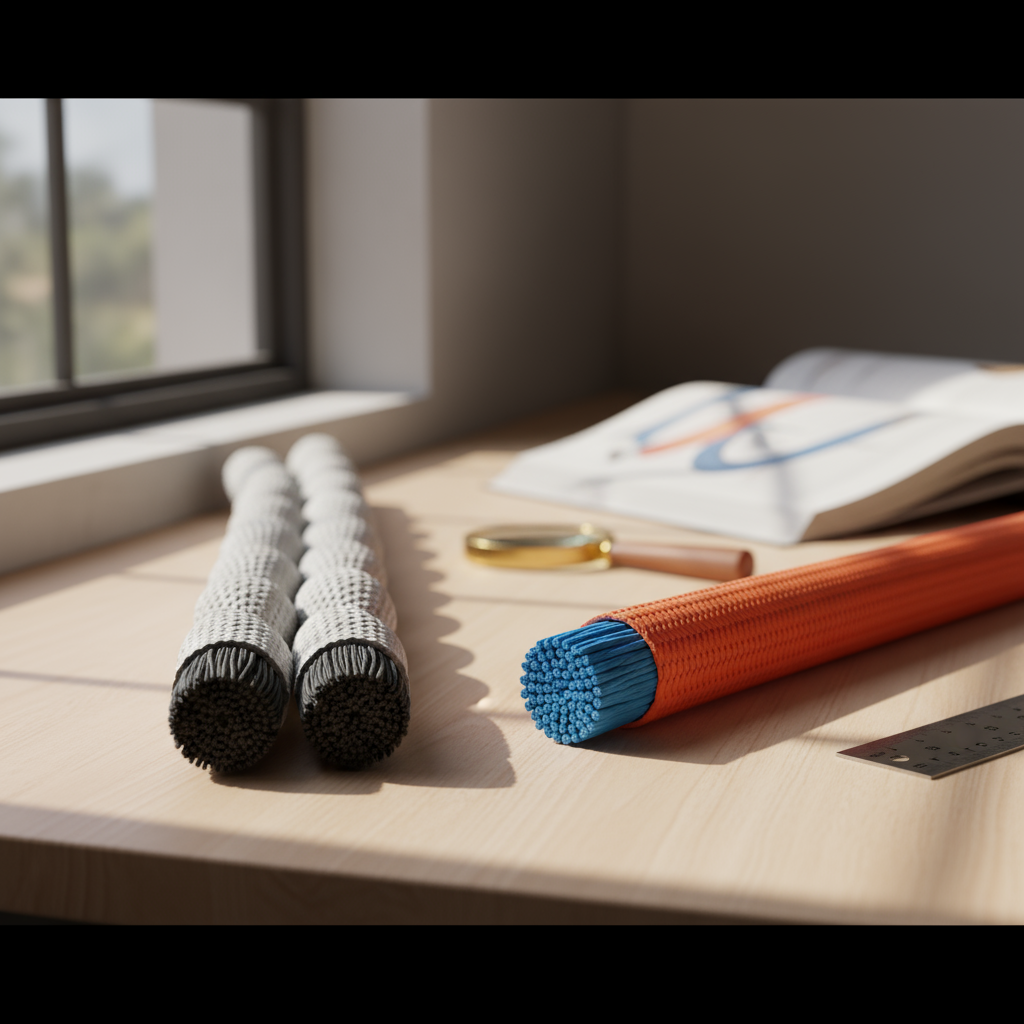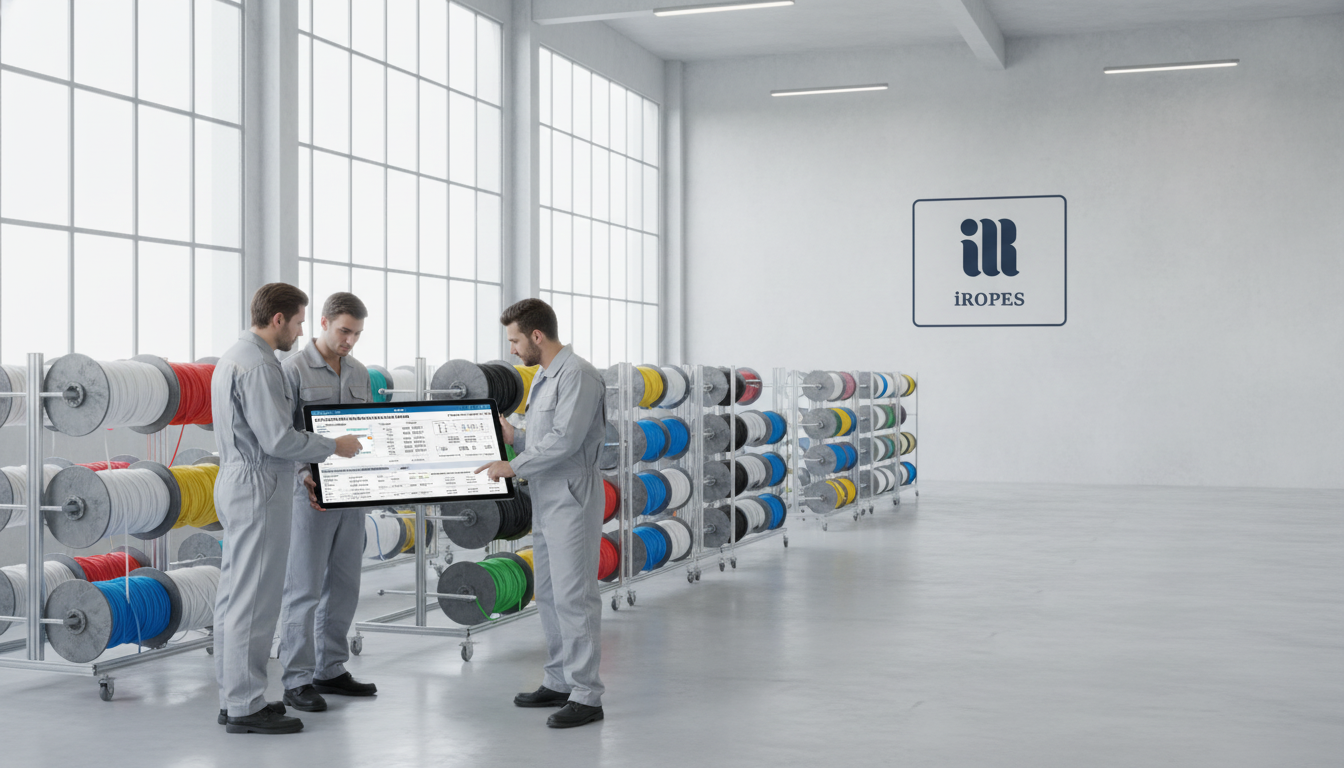iRopes offers 2,348 rope SKUs—including UHMWPE, Technora™ and Kevlar™—with custom OEM/ODM turnaround in 15‑25 days.
Your quick‑win checklist
- ✓ Cut your procurement risk with ISO 9001‑certified quality control.
- ✓ Match any load profile—our UHMWPE ropes offer up to 10× the strength‑to‑weight of steel.
- ✓ Save on freight via direct‑shipping pallets.
- ✓ Guard your IP and customise branding with bags, colour boxes or cartons.
Some assume “Made in China” means cheap, low‑grade rope. iRopes flips that idea with ISO 9001‑backed engineering and ultra‑light UHMWPE that outperforms steel on a strength‑to‑weight basis. With 15 years of experience making ropes in China and a catalogue of 2,348 SKUs, we build different kinds of rope for marine, racing, industrial and safety use. Our OEM/ODM service turns a simple coil into a performance‑driven brand asset. You’ll also see how direct pallet shipping trims logistics costs and how our IP safeguards keep your designs exclusive.
Exploring Different Kinds of Rope: An Overview
Imagine a rescue mission going wrong because the wrong rope was chosen. That is why the first step is knowing what you are dealing with. A rope is more than a twisted bundle of fibres; it is a system where material choice and construction together dictate strength, stretch, durability and even hand feel.

When you ask, “What are the types of ropes?” the answer breaks cleanly into three families. Each family groups ropes that share a common origin or performance goal, making it easier to match a rope to a job.
- Natural fibre ropes – made from manila, hemp or sisal; they are biodegradable and favoured for decorative or historic projects.
- Synthetic fibre ropes – include nylon (polyamide), polyester and polypropylene; they resist water, UV and abrasion, covering most everyday applications.
- High‑performance engineered ropes – built from UHMWPE, Technora™, Kevlar™ or Vectran™; they deliver excellent strength‑to‑weight ratios for demanding marine, industrial or safety uses.
All kinds of ropes therefore span from the humble natural fibres that have pulled ships for centuries, through the versatile synthetics that dominate modern outdoor gear, up to the ultra‑light, ultra‑strong engineered lines that keep offshore rigs and racing yachts moving at top speed. Understanding this taxonomy lets you ask the right questions about load capacity, stretch, floatability and UV resistance before you ever reach for a cutter.
With the basics of rope families clear, the next step is to explore the individual materials that give each category its unique character – from the shock‑absorbing nylon to the float‑ready polypropylene that never sinks.
Understanding Different Rope Materials and Their Properties
Now that you see how rope families are grouped, let’s dig into the actual fibres that give each line its personality. The material you pick determines not only how much load a rope can handle, but also how it behaves when exposed to sun, water or abrasion.
Natural fibre ropes still have a place in specialised projects. Manila offers solid tensile strength and stays relatively stiff, which makes it a favourite for historic rigging restorations. Hemp weathers sunlight better than many natural fibres, so it suits long‑term outdoor displays. Sisal is the workhorse of low‑budget applications; it offers decent abrasion resistance but sacrifices breaking strength compared with manila or hemp.
Synthetic ropes dominate most modern uses. Nylon (polyamide) delivers the greatest stretch of the common synthetics, providing a cushioning effect that protects both the load and the anchoring point. However, it absorbs water and can lose up to about 10% of its strength when wet. Polyester holds its shape with low elongation (often under 5%) and maintains strength even after prolonged UV exposure, which is why it’s a staple on sailing vessels. Polypropylene is the lightest of the lot; it floats naturally, making it ideal for lifelines or buoyant markers, but its lower strength means it’s best suited to non‑critical tasks.
When performance pushes the limits, high‑performance engineered fibres step in. UHMWPE (often marketed as Dyneema) leads on strength‑to‑weight – it can outperform steel by many multiples on a per‑weight basis – and it also floats, a rare combination for ultra‑light lines. Technora brings a blend of high tensile strength and heat resistance, which suits winches and high‑temperature contact points. Kevlar excels at cut resistance and offers minimal stretch, while Vectran provides low elongation with strong abrasion and creep resistance, making it a go‑to for high‑speed marine and industrial applications. Which type of rope is strongest? In a straight strength‑to‑weight comparison, UHMWPE leads the pack.

To decide which line fits your project, keep an eye on four key performance metrics. They act like a quick checklist before you order a coil.
- Tensile strength – how much load the fibre can bear before breaking.
- Elongation (stretch) – the amount a rope lengthens under load, important for shock absorption.
- UV & chemical resistance – durability when exposed to sunlight or harsh environments.
- Floatability – whether the rope sinks or floats, crucial for marine work.
“When you match the rope’s material to the job’s exact stress profile, you turn a good line into a reliable partner.” – Lead Materials Engineer, iRopes
Armed with the material breakdown, the next logical step is to see how those fibres are woven together. Construction methods – twisted, braided or plaited – change how the metrics above translate into real‑world performance, and they set the stage for the industry‑specific solutions that follow.
All Kinds of Ropes: Construction Methods and Performance Metrics
Now that the fibre families are clear, the next question is how those fibres are stitched together. The way a line is built determines whether it will splice neatly in the field, resist abrasion on a winch drum, or stay supple enough for a smooth belay.

Three‑strand (twisted) construction dates back to rope‑making ships, where a simple lay of three yarns created a line that could be tied or spliced with a basic eye‑splice. Because the fibres follow a helical path, the rope twists back onto itself, giving a predictable stretch profile that engineers value when calculating load and break points. The trade‑off is a slightly larger diameter for a given strength, and the outer lay can wear faster on abrasive surfaces.
Braided and plaited designs rearrange the same fibres into interlocking patterns. A solid braid interlocks strands into a compact, coreless structure with excellent handling. Double‑braid ropes combine a braided core with a braided cover, adding protection that suits marine rigging where salt and UV wear are constant threats. Hollow‑braid constructions have an open centre and, when made from buoyant fibres such as polypropylene or UHMWPE, they float—ideal for lifelines and marker lines.
Easy splice
Three‑strand ropes can be spliced with simple eye‑splice tools, ideal for field repairs.
Predictable stretch
Consistent elongation makes load calculations straightforward.
High strength
Braided ropes pack more fibres per diameter, delivering greater tensile capacity.
Low stretch
Minimal elongation helps maintain precise tension in rigging and winches.
Answering the common query “what rope floats?” – polypropylene and ultra‑high‑molecular‑weight polyethylene (UHMWPE) both stay buoyant, the latter adding a remarkable strength‑to‑weight ratio. For a deeper dive into how UHMWPE stacks up against traditional steel wire rope, see our UHMWPE vs steel rope comparison. When people wonder “which rope is most common?”, nylon is the workhorse; its balance of strength, elasticity and cost makes it a staple across recreation, industry and rescue.
Putting the pieces together, twisted lines excel in splice‑friendliness and predictable stretch, while braided ropes win on tensile strength, abrasion resistance and low elongation. Selecting the right construction therefore hinges on three questions: Do you need to splice on‑site? Is abrasion a primary concern? Must the rope stay afloat?
Quick tip
Need a floating rope with very high strength? Choose UHMWPE. Expecting shock loads? Choose nylon—its elasticity cushions dynamic forces.
With the construction landscape mapped, the next step is to see how each method fits into real‑world sectors – from marine racing to off‑road recovery – and how iRopes can tailor a custom solution that matches your exact performance envelope. If you’re focused on marine applications, explore the top benefits of double‑braided polyester ropes for yachting.
Custom Solutions and Industry Applications: Leveraging iRopes Expertise
Having mapped the construction landscape, it’s time to see how those methods become real‑world solutions. iRopes has spent 15 years perfecting a catalogue of 2,348 cordage SKUs, all produced under ISO 9001 quality control, so you can trust every coil to meet the same rigorous standards.

Our OEM/ODM service lets you decide every detail: the fibre (UHMWPE, Technora™, Kevlar™, polyester or nylon/polyamide), the diameter that matches your load‑bearing needs, colour coding for quick identification, and accessories such as loops, thimbles or specialised terminations. Throughout the process we protect your intellectual property, so the design you invest in stays exclusive to your brand.
iRopes guarantees ISO 9001‑certified production, ensuring every coil meets consistent quality standards.
Three recent projects illustrate the impact of a truly custom rope. A European off‑road recovery club switched from nylon to a custom 12 mm UHMWPE line and reduced tow‑line breakage by 62%. A racing‑yacht team adopted a UV‑stable polyester/polypropylene blend and achieved a 30% weight reduction with longer line life (three years versus one). Finally, a mining operation upgraded to a Technora‑reinforced 20 mm winch rope, increasing safe‑working‑load by 40% and cutting rope replacement costs by about 30%.
“Our OEM process lets you choose everything from fibre type to colour, while our IP protection safeguards your proprietary design.” – Senior Project Manager, iRopes
Ready to request a tailored quote? Simply fill out the online brief, attach any drawing or performance target, and our engineers will respond promptly. Typical OEM/ODM lead times run 15–25 days from design approval. Whether you need a single custom coil or a bulk pallet, the same ISO‑backed workflow ensures punctual delivery and consistent quality from a leading maker of all kinds of ropes. For tips on achieving strong, reliable splices, read our guide on rope making process and straight splice techniques.
Personalised Rope Design – Get Started Here
Having walked through the different kinds of rope, their material traits and construction styles, you now see how iRopes’ 15‑year legacy and 2,348 cordage SKUs enable you to choose the perfect line for marine, racing, industrial or safety use. From high‑performance UHMWPE and Technora™ to robust polyester and nylon, our OEM/ODM service tailors diameter, colour, accessories and IP protection to your exact needs. That way, you always choose a different rope for each task—backed by ISO 9001 quality and Made‑in‑China precision.
If you’d like a one‑to‑one consultation and a detailed quote, simply fill out the brief in the form above – our experts will get back to you swiftly with a solution built just for you.